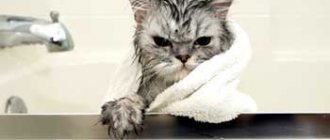In the material, we figured out whether it is necessary to bathe a cat, what determines the frequency of water procedures and when they are contraindicated. After reading the article, you will learn how often adult cats, kittens and purebred cats are bathed.
The washing process is important for your pet and its health. Caring housewives are interested in how often they can bathe their beloved cat. However, the procedure has its own characteristics. The frequency of washing depends on various factors. We will tell you how many times a year you can wash a pregnant cat, as well as a small kitten.
Cats are playful and active creatures. They love to walk outside, climb trees, and interact with other pets. Bathing a cat is a necessary procedure. To keep the animal healthy, the pet needs to be washed periodically. However, the process can become real torture for the owner, because animals do not like bathing.
Bathing a cat
Why and how often should cats be washed?
Most pets are exemplary cleanliness. Their tongue is able to clean the fur in a way that any washcloth would envy. But still, over time, the fur can stick together, begin to smell bad and become covered with a layer of fat.
You need to wash it if:
- the animal is not very clean;
- the cat got dirty somewhere;
- the wool began to smell;
- there are fleas and ectoparasites on the body.
The frequency depends on the cleanliness of the cat, the thickness of the coat and the time of year. Long-haired breeds are prone to matting, so they need to be washed more often.
Domestic cats can be bathed approximately 1-2 times a year. Cats that walk along the street - once every 3 months.
DO NOT wash animals:
- during illness;
- if the room is cold or there are drafts;
- if the cat is too afraid of this procedure, severe stress can lead to serious illnesses.
Should you wash your cat?
All pets need water treatments throughout their lives. You have to bathe them more than once, as dirt and tangles appear on the fur. But the owner wants to see his pet well-groomed and beautiful.
When should you bathe a cat?
You only need to wash your “cat” in justified situations, for example when:
- The fur is matted and the shine is gone.
- The “mustachioed naughty guy” knocked something over on himself, or climbed into something.
- If there are fleas. After bathing, treatment should be carried out.
- When there are signs of an allergic reaction, lichen, dermatitis and other skin diseases.
- A homeless “fluffy” was brought from the street.
- In preparation for the exhibition.
Some medical cases require a doctor's prescription.
What you need to bathe cats
Human shampoos are not suitable for washing. The pH of human and cat skin is different. The wrong cleanser can lead to dry skin, dandruff and even ulcers.
To bathe, you must purchase a special shampoo for cats in advance. If your pet has fleas, the detergent should have an antiparasitic effect.
Water temperature is about 37 C°. You will also need two towels to catch the water from the wool.
If your animal is terribly afraid of water, it is better to buy dry shampoo. The powder is applied to the coat and then combed out. It will collect dirt and grease, and also maintain friendship between the cat and the person.
Short-haired cats can be wiped with a wet towel. It will remove dirt and loose hair.
Bathing a cat before a show
Demonstration performances in such events require the ideal appearance of the pet. Before the exhibition, it is advisable to wash it with pet shampoo. Comb the wool, lay it with colorless gel and fix it with varnish. Owners often ask whether it is possible to wash a cat with human toilet soap. Here the answer is clear - under no circumstances! The soap has an unsuitable pH (acid-base balance) for the animal, and there is a risk of massive hair loss and partial baldness. Then you will have to give up the competition.
Of course, some pets live without water treatments and are quite happy. However, there are situations when you cannot do without a good bath. Let your four-legged friend's bathing always take place in a calm environment. Show the cat that you can be trusted, give him a treat and everything will go well.
We hope that we were useful to you, we are always glad to see you in our hotel for cats and cats, Cat Lounge
How to bathe cats correctly
Before the procedure you need to prepare:
- Feed the animal 2-3 hours before washing and do not give it any more food. Stress may cause your pet to vomit.
- Trim his nails. This will protect you from injury.
- Remove all objects from the bathroom that the cat could knock over and break.
- Place a mat or towel on the bottom of the bathtub. This is necessary so that the animal does not slip and feels confident.
- Brush your pet and untangle the tangles.
When everything is ready, pick up the cat and take her to the bath. Place it on the bottom and hold it with a confident hand. Loosen your grip, and the animal will immediately take advantage of this and jump out. But under no circumstances cause pain!
Gently wet the fur with a gentle stream of water from the shower. Strong pressure and noise will scare your pet. You can water it with water from a basin. It is important that the liquid does not get into the nose and ears. The latter can be plugged with cotton balls.
Then lather the cat's body and massage. The chin and paws are washed last. Rinse thoroughly with water. If necessary, repeat lathering.
At the end of the procedure, you can apply conditioner. It will help wash away any remaining shampoo and make the coat soft and shiny.
It is important to speak kindly to your pet while washing. Movements should be careful but confident.
Upon completion of the water procedures, squeeze the water out of the fur, wrap the cat in a towel and take it out of the bath. Then place it on a second towel, wrap it around it and gently rub the fur.
It is not necessary to dry your cat. It will dry itself perfectly. You can use a hairdryer if:
- the animal is not afraid of him;
- the house is cold;
- the day before the exhibition.
The air stream from the hair dryer should be at a temperature of about 40 C°. You cannot blow in the face - this is a threat to the cat.
How to wash a cat if she is afraid of water or bathes for the first time
What could be worse than bathing for a cat? The only thing scarier is swimming for the first time. Unusual surroundings, sounds, sensations, the procedure itself - all this is a lot of stress. Therefore, a cat can break out, bite and scratch, even if such behavior is unusual for it.
The first bath is best done together. One person holds the cat, the second one washes it. This way you can not only protect yourself, but also wash much faster.
While bathing, you need to talk to your cat in a calm and gentle voice, call him by his nickname, and praise him. After water treatments, it is not advisable to dry your cat with a hairdryer. The sound of a hair dryer can frighten the animal even more. At the end, be sure to give your cat a treat and praise her.
Kitten's first bath
You should start bathing a kitten at 4 months of age, not earlier. Babies are extremely sensitive to temperature changes, and improper bathing can lead to serious consequences.
You can start training 2 weeks after the complete change of teeth. For the process to go smoothly, you need to convince the kitten that water is not dangerous. To do this, place a bowl of water in the room and throw rubber toys there. The baby will become interested and try to play with them.
Then you can wash your paws, under the tap or in a basin. Pour some water into it and place the kitten. If the baby does not run away in panic, he is already ready for water procedures.
If fear is present, you can distract your baby with squeaky toys while washing. If you have a helper, ask him to blow soap bubbles. While the kitten is watching them, you can have time to wash it completely.
How to teach a cat to bathe
To prevent your pet from being stressed, it is necessary to accustom him to water in stages; it is better to start from an early age. It is not recommended to wash kittens until their permanent teeth appear. First, you can dip your paws in warm water. You can wash it for the first time 3 weeks after changing teeth. You need to let the animal adapt, you can’t rush. Babies are not as clean as their “moms” and “dads”; a kitten can get dirty due to its curiosity. In this regard, the recommendations of veterinarians say: - Young animals should be bathed as their fur becomes dirty.
Adult cat's first bath
An adult cat may react violently to attempts to place it in water. Therefore, patience is needed here. It is advisable to familiarize your pet with the environment in the bathroom in advance. To do this, put it in a dry bath and throw in your favorite toys. When the animal stops running away in panic, you can begin the first wash.
How to wash a cat for the first time in its life:
- Pour a few centimeters of water into the bath.
- Grasp the animal confidently and lower it smoothly.
- Apply water to the wool by scooping it out of the bathtub. If the cat is calm, this can be done from the shower.
- Lather the fur with shampoo and rinse thoroughly.
- Wrap the cat in a towel, blot it dry, and then dry it with a second towel.
The first bath should not take much time. An unpleasant and unfamiliar procedure will bring a lot of stress to your pet.
Washing procedure and several life hacks
The bathing procedure is labor-intensive for both the pet and the owner. The animal will break free from your hands and run away, so you need to prepare in advance and know how to behave.
The cat is bathing
- Preparing for the procedure.
The owner needs to purchase shampoo with a good composition, and you can also buy a massage mitten. Prepare clean, fresh towels to wrap your baby in after bathing.
Hair massage mitten
It is advisable to trim the nails before the procedure. The animal will escape from the hands and may accidentally scratch the owner.
There is no need to carry out the procedure if the pet is in a bad mood or is busy with something. Try to create a calm environment.
- Bathing
The water temperature should be from 37 to 40 degrees. Fill the bath with warm water to a depth of 10-15 cm. You can turn on the water in advance and let it sit for a while so that your pet doesn’t get burned.
Lower your pet onto its hind legs and hold it there for a while. The cat must understand that it is safe. Pet her and distract her with something interesting so that she is not afraid. When the baby calms down, you can start bathing. Rinse it with warm water using a shower.
If the animal is not very dirty, you don’t need to use shampoo. However, if your pet's fur is sticky and unpleasant to the touch, shampoo is advisable. Apply a little product to your hand and distribute evenly over your pet's body. To be more effective, you can use a massage brush. The sooner you wash off the shampoo, the better and safer it is for your cat.
- Washing off
After you wash your animal with shampoo, rinse off the product with warm water. Be careful not to get water into your pet's ears.
Make sure that no foam from the shampoo remains on your body.
- Drying
Remove the cat from the bath and wrap it in a clean, dry towel. Keep it wrapped for a few minutes to allow all the moisture to be absorbed. You should not use a hairdryer, because... this can dry out your skin.
- Combing
After drying the wool, it needs to be combed. You can use a comb or comb made of natural bristles.
Brushing a cat
How often to bathe different cat breeds
Any animal should be bathed once every 2-3 months if it walks around the yard.
Hairless cats (sphynxes, elves, etc.) can be bathed more often - once a month, and in winter - once every two months. As a rule, these cats love water and are not averse to swimming.
White, beige and peach cats need frequent bathing. They are washed with a special shampoo for light coats.
Choosing a bathing temperature
Is it possible to feed a cat both dry and wet food at the same time: examples of mixing
Before holding events, you need to pay attention to the following points:
- how many degrees in the room - in the bathroom and the room where the cat will dry, it should be at least 22 degrees;
- water - from 38 to 40 degrees, depending on the breed.
You can determine the comfort of the temperature by looking at your pet - if he is shaking with chills, then he is cold. Too hot water can cause serious burns to delicate skin; its readings should not exceed 40 degrees.
And some more tips on washing cats
- Do not bathe a pregnant cat or if she is nursing kittens.
- An adult, unneutered cat needs more frequent washing. Due to the secretion secreted, his fur gets dirty faster, becomes greasy and sticks together.
- At least two weeks must pass after the operation, and only then can the animal be bathed.
- If you adopted a pet from a shelter, you should not wash it in the first few days. Moving and swimming together is incredibly stressful.
- During the shedding period, washing helps to quickly get rid of dead hairs.
- Do not wash your animal while it is sick.
So, the frequency of bathing is a conditional indicator. It depends on the cat’s cleanliness, the characteristics of its lifestyle and conditions of detention. An attentive owner will always understand that his pet needs additional care and will carry out water procedures with maximum comfort. For professional haircuts and grooming, we recommend going to a pet salon.
When is swimming contraindicated?
It happens that bathing a pet is prohibited. It is important to know the contraindications when you can’t wash your cat?
Vaccinations
You should not wash your cat before vaccination.
When your baby needs vaccinations, you need to know some things about washing. You cannot bathe the animal before vaccination, because... They are done only on dry skin. It is worth holding off on the procedure or rescheduling your visit to the doctor to another day, when the baby’s coat is dry.
After vaccination, it is forbidden to wash the animal for 5-7 days, and sometimes for two weeks. However, all situations are individual. Ask your doctor for advice on when and how often to bathe.
Pregnancy
Carrying children is a lot of stress for a cat. A mother gives all her energy and strength to her babies. Animals do not like to bathe and experience fear during the procedure. It is not recommended to bathe a pregnant cat to avoid stress. On the contrary, it is worth creating comfortable conditions and a calm environment for her.
It is not recommended to wash a pregnant cat
After giving birth, you should also not wash the animal for a while. If the cat gets dirty, you can wipe the body with wet wipes or a wet towel.
Sterilization
After sterilization, you should take a break and not bathe your cat for one week, because... there are seams. It is advisable to ask your veterinarian when you can resume bathing procedures.
It is not advisable to bathe sterilized cats.
Diseases
If your pet is sick or not feeling well, do not allow situations in which the animal feels stressed. Wet skin prevents wounds from healing.
Exception: sometimes during illness a pet develops different discharge. Then you will have to bathe the sick baby.
Tips and tricks
To prevent water procedures from harming your pet, you need to follow the recommendations of veterinarians:
- do not bathe cats more than once every 2 months;
- if necessary, it is better to wipe the contaminated area with a damp towel or use dry shampoo;
- You should not direct the shower stream at your face; water can get into your ears and cause inflammation and even deafness;
- in the cold season, try to wash the animal less often, until the fur is dry, and protect it from drafts;
- You need to feed your pet no later than 2-3 hours before bathing, as stress may cause him to vomit;
- It is recommended to trim the cat’s claws first to avoid scratches;
- In the summer heat, you should not increase the frequency of bathing; you can alleviate your pet’s condition by periodically spraying it with water from a spray bottle or wiping it with a damp towel.
Frequently bathing cats is not recommended. For pets, once every 3-4 months is enough. The frequency of bathing depends on many factors. There are situations when extraordinary washing is required. It is easy to determine that a cat is dirty: its fur is shiny, matted or collected in icicles, and an unpleasant odor appears. If you do everything correctly and follow the advice of veterinarians, your pet will not experience stress.
How and when to wash a kitten for the first time and with what?
Unless there are any special circumstances, a mother cat successfully cares for her babies, including their fur. In the first month from birth, healthy kittens do not need bathing.
You need to wash your kitten for the first time at the age of 3-4 months.
IMPORTANT: Veterinarians advise giving a kitten a bath for the first time at the age of 3-4 months.
It is not recommended to bathe younger kittens because:
- baby may get scared
- if he's with his mom, she might not recognize him as smelling like shampoo
- The baby has not yet established thermoregulation, he may freeze and get sick
IMPORTANT: Kittens that have been vaccinated should not be bathed for 10-14 days.
So, the decision was made to wash the kitten. What's the best way to do this?
- The procedure should be carried out 2 hours after feeding the kitten.
- It is necessary to prepare the bathing area so that cat shampoo and two terry towels are at hand. How to choose a shampoo can be read below.
- It is better to bathe a kitten not in the bathtub, but in the sink and basin. Lay a terry towel or cotton sheet on the bottom.
- Approximately 5 cm of water is collected in a sink or basin. Her temperature is measured. 38 degrees is the optimal indicator.
- It is better to turn off the tap while bathing the kitten; the noise of the water may frighten it. You can wash off the shampoo with a ladle or a mug. If the wool is dense, it can only be washed with running water; the stream from the tap or shower should not be under high pressure.
- The kitten should not be immersed in water abruptly, starting with its hind legs. At the same time, it is important to stroke him and calm him down.
- Perhaps, like a child, a kitten will tolerate bathing more easily if it has balls and toys - squeakers - that will distract it from the unpleasant procedure.
- You need to water the kitten's body very carefully, making sure that water does not get into the eyes and ears. The shampoo should be rinsed off the fur thoroughly.
- After bathing, the baby should be wrapped in a towel to prevent him from freezing. When the towel gets wet, it should be replaced.
- Dry the kitten's fur with a soft brush or hairdryer if he is not afraid of it.
To calm your kitten while bathing, you need to talk to him. Your pet's favorite toy will also help.
IMPORTANT: The success of subsequent baths largely depends on the kitten’s first bath. If it went smoothly, the adult animal will treat the procedure calmly and indifferently. If the baby has experienced stress, in the bath he will be a real demon, which will be difficult to cope with even together.
Is it possible to bathe a cat in the heat?
If a cat suffers from the heat in the apartment in the summer, the owners may want to give it a bath to refresh it. But frequent bathing, as is already known, can be harmful. Therefore, “refreshing procedures” are recommended to be carried out as follows:
- place a wet towel within reach of the animal so that it can lie on it or wet its paws
- spray the cat with water from a spray bottle
- wipe the cat's head and paws with a damp cloth
And even in these cases, the water should not be very cold so that the cat does not catch a cold.
When should you bathe your pets?
By nature, most cats are very clean animals. In any time free from sleep, food or entertainment, they lick their fur and put their fur coat in order.
One might decide that the issue of pet hygiene has been resolved. But that's not true. There are times when cats need to be washed with human intervention.
You need to wash your cat as needed in the following cases:
- If the animal was picked up from the street or leads a wandering lifestyle. Yard cats, who are allowed to walk in the courtyard of the house, along the street, or only during the “mating season,” always return dirty. Even if the cat visually seems clean, it is not. The dirt carried on the fur will remain on the floor, furniture, and end up in the animal’s food. It is not recommended for children to come into contact with unwashed walking animals.
- If the animal gets dirty. Sometimes animals, due to their curiosity, can get into various substances, for example, something sticky, sweet, toxic. In this case, it is better to quickly wash the cat before he begins to lick himself.
- During the molting period. When this time comes, cats begin to wash themselves much more often. This procedure involves collecting all the fallen hairs with the tongue. As a result, wool accumulates in the animal’s stomach, causing problems with digestion, stool, and discomfort. Cats with long hair can even develop intestinal obstruction. Therefore, you should definitely bathe your cat if it begins to shed.
- If the breed has an overly dense undercoat. The presence of thick fur is a case when a cat is not able to fully clean itself up on its own.
- If your cat's fur becomes oily too quickly. In some animals, the work of the sebaceous glands is increased naturally or due to illness.
- When your pet has fleas. In this case, swimming cannot be avoided. You will need a special anti-parasite shampoo.
- If the cat is a hairless breed. The body of Sphynxes and similar breeds is different from that of other cats. Their skin gets dirty faster than their fur, so they should be bathed more often. Or at least wipe with a damp cloth.
- Before a competition, competition, exhibition. A washed, brushed and combed contestant will look more advantageous.
Even if nothing happens from such cases, you should not refuse to bathe your pet.
Changed environmental conditions, synthetic food, dirty water and air leave a negative impact on the condition of the fur and skin of pets. The best way to care is bathing.
© shutterstock
How to dry an animal
It is necessary to ensure that the air from the hair dryer is not too hot
To do this, it is better to take several old cotton sheets, although it is better to take your pet out of the bathroom in a terry towel, holding it tightly to you. By blotting the cat one by one with the sheets, you can easily and quickly collect excess moisture from it. You can complete the procedure with a hairdryer if the animal does not object.
For sensitive tailed individuals, a soft bath towel is offered as an alternative. The cat should be wrapped like a baby and lulled to sleep for a short time in your arms or in a warm corner of the sofa. After a nap in warmth and comfort, he will emerge from the towel semi-dry and relatively happy, but it may take two days for him to dry completely.
To wash or not to wash
In order to understand whether a cat can be washed, it is important to know that not all dirt can be removed by them on their own. A water procedure should only be carried out in exceptional cases - before going to an exhibition or seeing a doctor. also need to bathe the animal occasionally if there are children in the house who will play with the cat. Additionally, those pets who have to fight fleas and other parasites that affect the skin or coat will have to undergo this test.
© shutterstock
For this purpose, not only water is used, but also special hygiene products - shampoos, which contain special agents to influence parasites. In addition, cats that spend a lot of time outside cannot avoid washing. It is best to purchase shampoos for washing cats in pet stores or veterinary clinics, since they undergo strict control there; the owner will be confident that he will not harm the pet by using a hygiene product during the bathing process.
What's the best way to wash your mustachioed friends?
Owners often use regular human shampoo or soap to wash their pets. Not everyone knows that this should not be done - you cannot bathe cats with ordinary or even children's products. A special shampoo with a special composition is developed for their skin type. There are two types of shampoo:
- Liquid shampoo - cares for the coat thanks to its natural ingredients.
- Dry shampoo is a product for applying to an animal's fur without using water. If it absolutely refuses to be bathed, then you can use the combing method using a dry cat wash. Visually, the shampoo resembles baby powder.
© shutterstock
When is it not permissible to wash cats?
There are several contraindications for bathing cats:
- the animal is scared or aggressive;
- the pet has recently experienced severe stress;
- the cat has recently had surgery (you must wait at least two weeks);
- the animal is sick or has significant skin damage.
You should also not bathe your cat immediately after eating.
If your pet has fleas or lice that cause it to constantly itch, in order to avoid intoxication of the pet, you should not wash it frequently with anti-flea shampoo.
Cat Wash Products
It is recommended to bathe pets using special products that can effectively remove all dirt from the fur. Plain water is powerless here: you won’t be able to get rid of excess sebum and unpleasant odors without shampoo. Use only special high-quality products for cats, as they effectively cleanse the skin and fur without washing away the natural protective layer, and also nourish them with beneficial elements.
Soap and human shampoos are categorically unsuitable for animals in terms of pH level and negatively affect the condition of the skin and coat. Unsuitable products often cause dandruff and dermatitis, and the coat becomes dull and lifeless after using them.
Inappropriate shampoos are especially dangerous for small kittens and weakened cats. No matter how thoroughly you rinse your cat after washing, the chemical will still remain on it. If it gets into the stomach when washing, it is highly likely to provoke a serious eating disorder.
What determines the frequency of bathing?
The frequency of bathing varies from cat to cat. It depends on whether the pet is walking outside, what age and breed it is, and how it feels. Some animals need to be washed more often, while for others a few times a year is enough. You should not frequently subject pets that do not go outside to this procedure. They are protected from street dirt and parasites.
Influence of breed and coat length
The frequency of bathing depends on the breed, color and coat type. General rules apply to ordinary cats. Hairless and long-haired animals require more frequent washing. Long hair requires special care, otherwise it will fall into tangles. Such cats are bathed once every 1-2 months.
Hairless breeds, such as the Sphynx, usually enjoy bathing. Many owners wash them every week. These cats have increased activity of the sebaceous glands; without bathing, the skin becomes oily and can stain furniture.
Light-colored animals can be bathed more often. On white, light gray or beige wool, dirt is more visible. It is recommended to use a special shampoo for light coats.
Age
In the first 3-4 months of a kitten's life, bathing is not recommended. If he is domestic, his mother takes care of him, licking his fur. If you bathe a kitten using shampoo, the cat may not like the smell and will not allow the baby to come near it. Washing is also not recommended for the reason that kittens have weak immunity, so after bathing they can catch a cold.
Adult sterilized animals that do not go outside do not need frequent bathing. Their sebaceous gland activity is reduced and they behave calmly. Older animals also need to be washed less often. A stressful situation can negatively affect them. Moreover, they lie longer and therefore get dirty less.
Drying the cat after washing
It is not necessary to blow-dry your cat after washing or create greenhouse conditions for it. A healthy pet will dry out calmly at average room temperature. But there should be no drafts in the room, otherwise the cat may catch a cold.
Don't forget that for many animals, bathing is a huge stress. Be gentle with your pet, talk to him and do not punish him in any way, because he is not capricious, but truly afraid. Teach your pets to bathe from an early age so that in the future they will take this procedure calmly.











